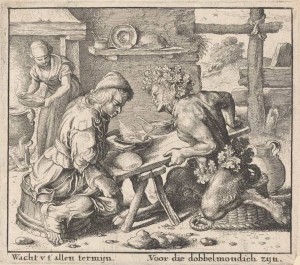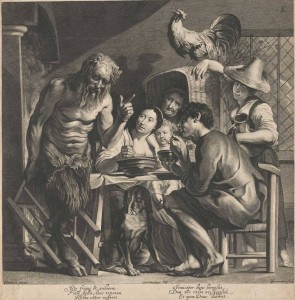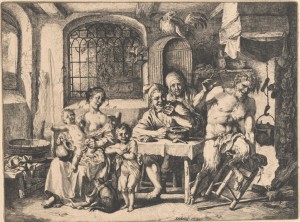Why Satyrs Won’t Eat Soup
Satyrs, or hybrid beings who are part-human and part-goat, are famed for their love of wine and bawdy behaviour. Marcantonio Raimondi’s Bacchanal (1510-27) derived from an ancient sarcophagus bas-relief, and displaying a lot of drunken followers of Dionysus, is characteristic of the type of activities associated with satyrs. However, as a number of printed examples reveal, a bowl of soup placed before a satyr elicits some surprisingly sober conduct.

The satyr and the peasant (1644-52) shows the satyr intensely fixated on the rustic’s mouth, who is lustily blowing on his soup while his wife tends the cooking in the background. The etching is after an image which appears in Aegidius Sadeler’s Theatrum morum (1608) which in turn is after Eduard de Dene’s version of Aesop’s Fables: De warachtighe fabulen der dieren illustrated by Marcus Gheeraerts (1567).[1] Just as the image is a variation on a common idea, the original fable from Aesop formed the inspiration for many depictions of the satyr taking the moral high ground when it comes to soup.

Versions of the fable concern a traveller or peasant who takes shelter from wintry weather in a satyr’s cave. This mythological woodland creature is both amazed and horrified to witness the man blow on his hands to warm them, and then proceed to blow on his scalding cup of wine to cool it. ‘The man’s host shook with terror, dumbfounded at the double portent. The satyr drove his guest out into the woods and ordered him to be on his way. ‘Do not let any man ever come near my cave again,’ said the satyr, ‘if he can breathe in two different ways for the very same mouth!’’[2] It was this fable which coined the saying ‘to blow hot and cold.’
The scene has developed further in the image engraved by Lucas Vorsteman and it is the satyr who is now visiting the peasant’s house. The family group appear enthralled and even flabbergasted by the sage satyr who stands to leave, wagging an admonishing finger over his untouched soup. While a rooster, the bird which announces betrayal in the Bible eyes the satyr speculatively, and a loyal dog skulks under the table.

The mood is much less serious in the same scene portrayed by Christian Wilhelm Ernst Dietrich. It is almost as if the satyr has just told the family an amusing story as he overbalances his chair. The child on the mother’s lap reels back and the other child grins in a crude state of undress. It is only the grandmother engaging the viewer from the background, who seems to blow a cold wind of morality through the picture.

Transferred from the Rowden White Library 1982.
Kerrianne Stone (Curator, Prints)
[1] Richard Pennington, A descriptive catalogue of the etched work of Wenceslaus Hollar, 1607-1677, Cambridge [Eng.]; New York: Cambridge University Press, 1982, p. 64
[2] Aesop’s fables by Aesop; translated with an introduction and notes by Laura Gibbs, Oxford: Oxford University Press, 2002, p. 174
Categories
- Uncategorised
- Prints
Leave a Reply